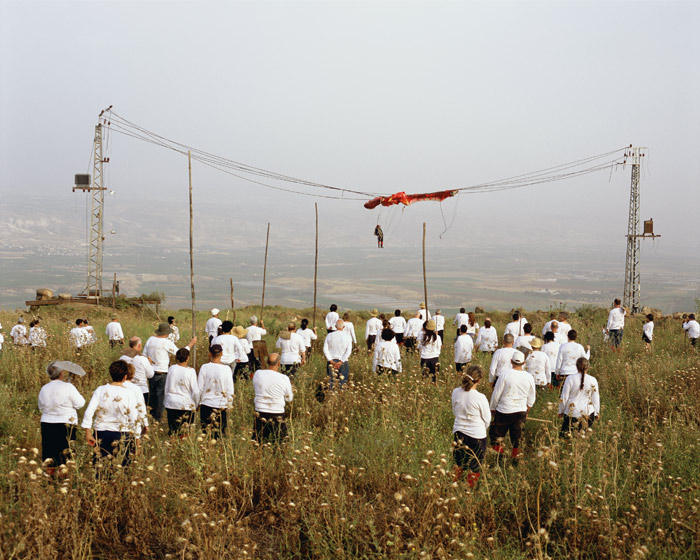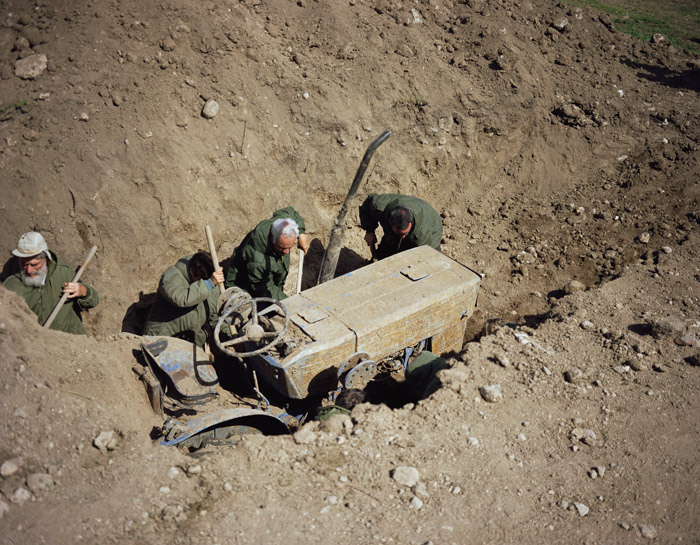Charlotte Meyer: Your work has incorporated, and mainly been shot in the Israeli landscape. Your ideas have included raising something, a tractor from the earth in your most recent film elevating your father onto a high platform in your 2009 video 50 Blue, and saving somebody, as in the hanging entangled parachutist in Nothing New of 2012. How does the idea of community also become the subject of these works?
Oded Hirsch: The core subject of my work is bringing the community to act together, to work together, and to be engaged in a communal collaboration. That is the core, all the rest is just an excuse. The visual language and the narrative are important, of course, but they come second. The heart of my work is convincing people to act, to make art together. That’s the main aspect, that’s what my work is about. Another aspect that interests me is creating challenging situations where people have to unite and work together as an organism. For example, in my last film there is a tractor buried underneath the ground. I asked a group of ten villagers to uncover and pull the tractor out, all by hand. That was the situation that the workers have to deal with. So the situational component is really a common theme in the work.
CM: There is a palpable emotional force that is present, a back story to your work that is very connected to your psyche, even when the narrative is clear, there is ambiguity, you are still leaving a lot to the audience.
OH: Basically it’s about my Dad, my relationship with my father. My father is always present in my life and work. He was a truck driver and when I was five years old he had a truck accident that left him paralyzed from his chest down. I have no memory of him walking, for me he was always in a wheelchair. Eventually I became interested in art and I had this vision of lifting him up and put him up on an unexpected spot just for a photograph. I wanted to place him on a big rock, a building, a ladder—an inaccessible platform and look up toward him. When I grew up I grew taller and taller and he always stayed the same height because he was in a wheelchair. So, my idea was to lift him up and look up at him, changing the angle of looking. This film has developed from this childhood longing.
CM: You went to great lengths. Your father wasn’t able to be physically available in your life since you were five. That physical burden made visible or manifest in 50 Blue with not only your brother assisting him by wheeling him across the Israeli landscape, but you include your family and the community to raise him up the platform you had built. You physically pushed those limits.
OH: Right, when you growing up with an un-walking Dad you think of accessibility all the time. You think of motion, you see everything as a physical feat. Motion and accessibility became major issues in my life. The simple action of climbing the stairs becomes a huge challenge. I started to look at the world through my father’s disability. Its not just any person, its my dad—the person that set the example for me as a little boy. So it became a major issue, the burden, the hardships, the incapability. I think it’s also present in the situations that I develop in the films. Everything is awkward and heavy and cumbersome. People push big wheels uphill, they carry huge poles, it all comes from this primordial desire of mine to see my invalid dad on top of an inaccessible spot.
CM: The mind-body connection somehow was disrupted or interrupted for you. There is a physicality that you are questioning always. The hoisting of the rope—it doesn’t take one person, it takes many people to make this happen.
OH: I think that’s another context story, I grew up in a kibbutz. It’s a small community, everybody knows each other, everybody depends on each other. It’s an ideology driven organization that is based on communist ideas of social equality and sharing. The community is like a big family that provides for its members, it creates living conditions of great dependence.
CM: That is in complete opposition to being here in America.
OH: Of course it’s a magnificent contrast. I think my work tries to explore the boundaries where the individual ends and the community begins. I seek the tension between the private and the collective. There is a theme that repeats in several of my works in which the entire society is being recruited to rescue one of their sons, this is where I manifest this tension. I also play with how much the identities are obscured, because the participants are usually covered.
CM: They are anonymous.
OH: Yes, they look and act like an ant farm, everyone fills their role silently.
CM: You make collaboration happen in Israel from here. You have this ability to get everyone involved in your films, and you are about to go and physically make work with people again in the Ein-Harod museum in Israel. How are you able to make that happen in Israel from here?
OH: Maybe because I am in between, an insider, and an outsider at the same time. I left the Kibbutz and live in New York now, it gives me the opportunity to create these kind of spectacles. Since I come with the title of an artist, people actually go along with me. It’s really rewarding. In Nothing New I had a 90 year-old member, his name is also Oded. He came to me while filming and said that he hadn’t seen so many people together working in the field in 25 years. This is something I will remember forever. It’s very hard to convince people to participate, but with every production it becomes easier because the circle grows bigger and bigger. I started with ten people in my first film and it became 25, then it became a couple hundred. It’s a powerful experience to see all these people actually doing something together, and there is no incentive other than the pure idea of making art together.
CM: You are touching on another important component of the work though. In the kibbutz lifestyle community is first, this is key to the work you are doing.
OH: Yes, definitely. The context of my personal background, where and how I grew up, this is the junction where the community and the individual intersect and become present in my work. I try to create that equation.
CM: Even though there are no words but still a narrative, you have developed a strong visual language.
OH: Yes, in a way when you work with people in the field it’s exactly that. You don’t have to communicate with people verbally. As a worker in a factory you know your role in the assembly line and you know that each one must just do his job. There is no need for unnecessary distractions. You work together as an integral organized group that functions as a body together. For me talking is a distraction, there is no need for it in my films.
There are so many things that are being communicated without saying a thing, so many visual codes. Everything is something that tells the story of who you are. It’s the same in the kibbutz, but in a very different way. The codes are different, for example how dirty your clothes are, how rugged your hands, how strong your grip feels when you shake hands.
CM: The visual language is tied to who the person is and what they do with their day, which makes the mind-body connection so present in the work.
OH: There are many visual codes. I think that what makes the mind-body connection is the strict authenticity. The participants are Kibbutz members, not just random actors, and they really work hard out there to create those spectacles. In my last piece I had a 75 yr old who broke his back on set, it wasn’t nice. I went to visit him in the hospital and he was so happy for the opportunity to participate. He is OK now. People work hard and you can sense it in the intensity of the actions that are being performed. For the short time of filming it’s a mini-scale utopia in a bubble. I think there is art that can bring people together, I try to integrate that notion into the visual language that I continue to develop and work on.

























